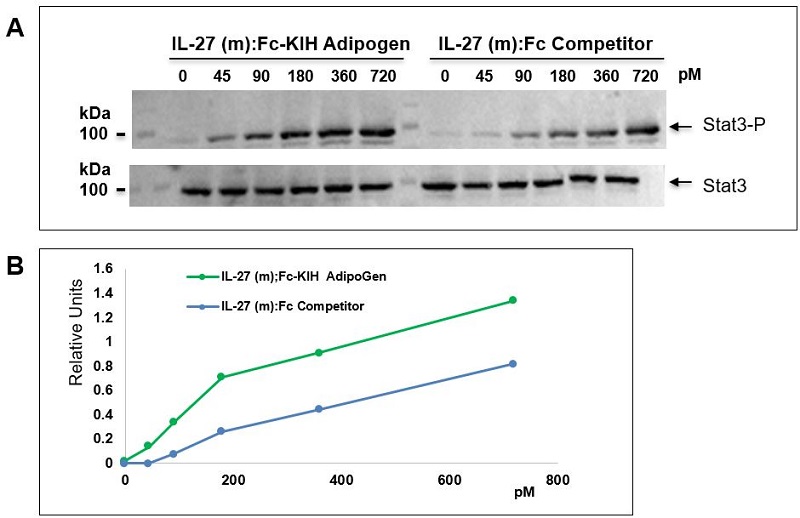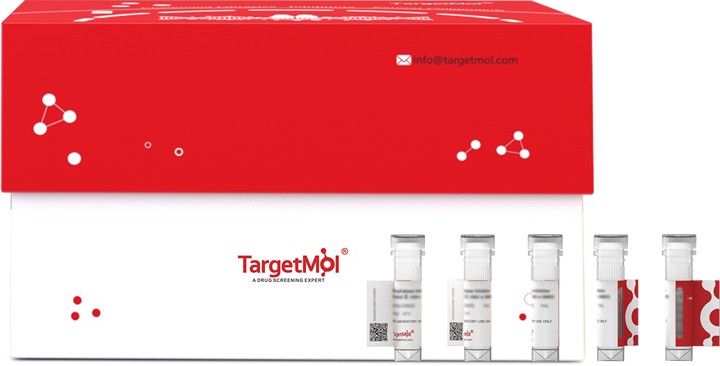
IL-27 (mouse):Fc-KIH (human) (rec.) (#AG-40B-0236) (Heterodimer) is more active than an IL-27 (mouse):Fc from a competitor (Dimer of Heterodimer). Method: 5x104 HepG2 cells (a human hepatocellular carcinoma cell line) are treated with IL-27 (mouse):Fc-KIH (human) (rec.) (#AG-40B-0236, AdipoGen) or from IL-27 (mouse):Fc (human) from a competitor at different concentrations indicated on the figure for 15 minutes. Cells are lysed and cell extracts are separated by SDS-PAGE (12.5%) under reducing conditions, transferred to nitrocellulose overnight and incubated with anti-Phospho-Stat3 (Tyr705) (human), Rabbit Monoclonal (RM261) (#REV-31-1142-00) (1/1000) or anti-Stat3, Rabbit Monoclonal (RM465) (#REV-31-1357-00) (1/1000). After the addition of an anti-rabbit secondary antibody coupled to HRP (1/10000), proteins are visualized by a chemiluminescence detection system. A) Western Blot, B) Quantification figure of the Western Blot.
IL-27 (mouse):Fc-KIH (human) (rec.)
AG-40B-0236
Protein IDO35228
Product group Proteins / Signaling Molecules
Overview
- SupplierAdipoGen Life Sciences
- Product NameIL-27 (mouse):Fc-KIH (human) (rec.)
- Delivery Days Customer10
- CertificationResearch Use Only
- Concentration1 mg/ml
- Estimated Purity>95%
- Protein IDO35228
- Protein NameInterleukin-27 subunit beta
- Scientific DescriptionInterleukin-12 (IL-12) family members are heterodimer glycoproteins, composed of two covalently linked subunits, alpha and beta chains. The alpha-subunit consists of IL-23p19, IL-27p28, and IL-12p35, and the beta-subunit includes IL-12p40 and Epstein-Barr virus-induced gene (Ebi3). IL-12 members bind to cognate heterodimeric receptor chains expressed on T cells. This family includes IL-12, IL-23, IL-27 and IL-35 and IL-39. IL-12 and IL-23 are predominantly proinflammatory cytokines that contribute key roles in the development of Th1 and Th17 cells, respectively. IL-27 has both pro- and anti-inflammatory properties and is a potent T cell immunomodulator. IL-35, a new member of this family, is a potent inhibitory cytokine produced by natural, thymus-derived regulatory T cell (nTreg) populations. IL-39, the newest member of IL-12 family, mediates the inflammatory response through the activation of STAT1/STAT3 signaling pathway. These IL-12 family members link innate immunity with the development of adaptive immunity and are also important for regulating T cell responses. IL-27 is composed of two subunits, IL-27p28 and Epstein-Barr virus-induced gene 3 (EBI3) signals via a heterodimeric receptor consisting of WSX-1 and glycoprotein (gp130), leading to activation of STAT 1 and 3. IL-27 is pro-inflammatory and promotes NK and T cell proliferation as well as the production of IFN-gamma. It is anti-inflammatory, inhibiting Th2 and Th17 cell activities and stimulating the production of IL-10 by T regulatory cells. IL-27 has potent antiviral activities against numerous viruses, by increasing the production of interferons (IFNs). Finally, IL-27 has antitumor activity as well as anti-angiogenic activity with activation of the production of anti-angiogenic chemokines. The protein IL-27 (mouse):Fc-KIH (human) (rec.) is produced by using two different vectors, one encoding for the IL-27A/p28:Fc Knobs sequence (synthesizing a protein of 62kDa) and one encoding for the IL27B/EBI3: Fc Holes sequence (synthesizing a protein of 60kDa). Both vectors transfected into CHO cells produce both Fc molecules (Knobs-into-Holes technology; J.B. Ridgway, et al.; Protein Eng. 9, 617 (1996)) required for dimerization and for secretion of the final protein IL-27 (mouse): Fc-KIH (human) (rec.). InVivoKines™ are a new generation of recombinant fusion proteins for immunotherapeutic, preclinical and translational in vivo research, developed and manufactured by AdipoGen Life Sciences. - InVivoKines™. Recombinant protein. IL-27A/p28 (aa 29-234) (mouse):Fc Knobs and IL-27B/EBI3 (aa 19-228) (mouse):Fc Holes form the IL-27 (mouse):Fc-KIH (human) using the Knobs-into-Holes technology (see reference: J.B. Ridgway, et al.; Protein Eng. 9, 617 (1996)). Activates STAT3 phosphorylation in mouse and human cells. Source: CHO cells. Lyophilized. Contains PBS Interleukin-12 (IL-12) family members are heterodimer glycoproteins, composed of two covalently linked subunits, alpha and beta chains. The alpha-subunit consists of IL-23p19, IL-27p28, and IL-12p35, and the beta-subunit includes IL-12p40 and Epstein-Barr virus-induced gene (Ebi3). IL-12 members bind to cognate heterodimeric receptor chains expressed on T cells. This family includes IL-12, IL-23, IL-27 and IL-35 and IL-39. IL-12 and IL-23 are predominantly proinflammatory cytokines that contribute key roles in the development of Th1 and Th17 cells, respectively. IL-27 has both pro- and anti-inflammatory properties and is a potent T cell immunomodulator. IL-35, a new member of this family, is a potent inhibitory cytokine produced by natural, thymus-derived regulatory T cell (nTreg) populations. IL-39, the newest member of IL-12 family, mediates the inflammatory response through the activation of STAT1/STAT3 signaling pathway. These IL-12 family members link innate immunity with the development of adaptive immunity and are also important for regulating T cell responses. IL-27 is composed of two subunits, IL-27p28 and Epstein-Barr virus-induced gene 3 (EBI3) signals via a heterodimeric receptor consisting of WSX-1 and glycoprotein (gp130), leading to activation of STAT 1 and 3. IL-27 is pro-inflammatory and promotes NK and T cell proliferation as well as the production of IFN-gamma. It is anti-inflammatory, inhibiting Th2 and Th17 cell activities and stimulating the production of IL-10 by T regulatory cells. IL-27 has potent antiviral activities against numerous viruses, by increasing the production of interferons (IFNs). Finally, IL-27 has antitumor activity as well as anti-angiogenic activity with activation of the production of anti-angiogenic chemokines. The protein IL-27 (mouse):Fc-KIH (human) (rec.) is produced by using two different vectors, one encoding for the IL-27A/p28:Fc Knobs sequence (synthesizing a protein of 62kDa) and one encoding for the IL27B/EBI3: Fc Holes sequence (synthesizing a protein of 60kDa). Both vectors transfected into CHO cells produce both Fc molecules (Knobs-into-Holes technology; J.B. Ridgway, et al.; Protein Eng. 9, 617 (1996)) required for dimerization and for secretion of the final protein IL-27 (mouse): Fc-KIH (human) (rec.).
- Storage Instruction-20°C,2°C to 8°C
- UNSPSC12352202



